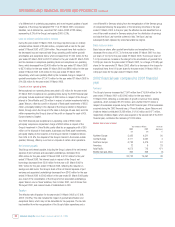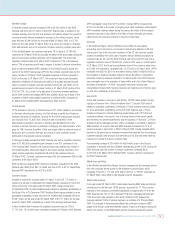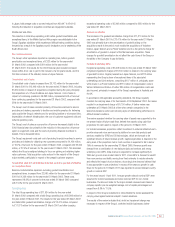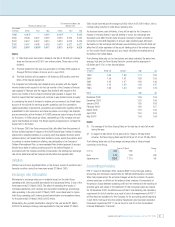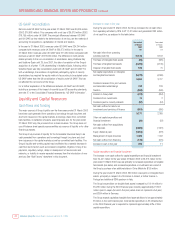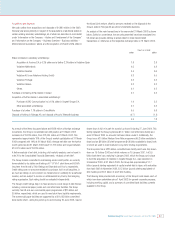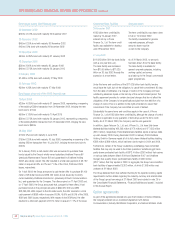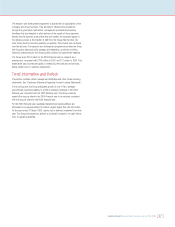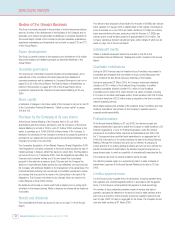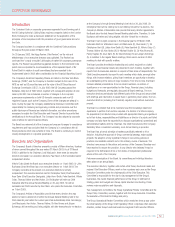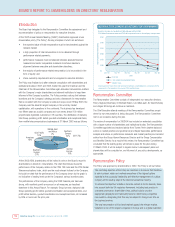Vodafone 2003 Annual Report Download - page 48
Download and view the complete annual report
Please find page 48 of the 2003 Vodafone annual report below. You can navigate through the pages in the report by either clicking on the pages listed below, or by using the keyword search tool below to find specific information within the annual report.
Vodafone Group Plc Annual Report & Accounts and Form 20-F 2003
46
OPERATING AND FINANCIAL REVIEW AND PROSPECTS Continued
Interest rate management
The Group’s main interest rate exposures are to euro and yen and, to a lesser
extent, dollar and sterling interest rates. Under the Group’s interest rate
management policy, interest rates on monetary assets and liabilities are
maintained on a floating rate basis, unless the forecast interest charge for the
next eighteen months is material in relation to forecast results in which case
interest rates are fixed. In addition, fixing may be undertaken for longer periods
when interest rates are statistically low. Therefore, the term structure of interest
rates is managed within limits approved by the Board, using derivative financial
instruments such as swaps, futures, options and forward rate agreements. At the
end of the year, 9% (2002: 38%) of the Group’s gross financial liabilities were
fixed for the twelve month period ending 31 March 2004. Based on all interest
rate sensitive instruments, a one hundred basis point rise in market interest rates
for all currencies in which the Group had borrowings at 31 March 2003 would
affect profit before taxation by approximately £90 million. The interest rate
management policy has remained unaffected by the acquisitions completed
during the financial year.
Foreign exchange management
The Group’s policy is not to hedge its international assets with respect to foreign
currency balance sheet translation exposure, since net tangible assets represent
a small proportion of the market value of the Group and international operations
provide risk diversity. However, 95% of net borrowings were denominated in
currencies other than sterling (49% euro, 36% yen, 8% USD and 2% others) in
anticipation of cash flows from profitable international operations and this
provides a partial hedge against profit and loss account translation exposure. A
relative weakening in the value of sterling against certain currencies of countries
where the Group operates has resulted in a currency translation adjustment of
£9,039 million credit to Group reserves in the year ended 31 March 2003
(2002: £2,263 million charge).
Foreign currency exposures on known future transactions are hedged, including
those resulting from the repatriation of international dividends and loans above a
certain de-minimus level. Forward foreign exchange contracts are the derivative
instrument most used for this purpose.
A 10% strengthening of sterling against all currencies in which the Group’s
international net earnings are denominated would reduce the 2003 total Group
operating loss by £595 million (2002: £1,156 million reduction).
Counterparty risk management
Cash deposits and other financial instrument transactions give rise to credit risks
on the amounts due from counterparties. The Group regularly monitors these
risks and the credit ratings of its counterparties and, by policy, limits the daily
settlement and aggregate credit risk it may have with one counterparty. While the
Group may be exposed to credit losses in the event of non-performance by these
counterparties, it considers the possibility of material loss to be acceptable
because of these control procedures. Additional information is set out in notes 20
and 21 to the Consolidated Financial Statements “Financial liabilities and assets”
and “Financial instruments”.
Research and Development, Patents and
Licences, etc.
The Group Research and Development (R&D) function was formed in April 2001
out of the Vodafone research and development teams in Newbury, Maastricht,
Vodafone Pilotentwicklung in Munich and the Strategic Technology team in
Walnut Creek, USA. Since then, centres of excellence in Milan and Madrid have
been added, and the addition of a centre of excellence in Tokyo is being
finalised, thereby creating an international and multicultural team for applied
research in mobile communications and its applications.
The work of the Group R&D function is divided broadly into four categories.
These categories are technical leadership and research support for the work of
Group Strategy, research into technology that will typically start to be used in
Vodafone’s business in three or more years time, leadership for the Group’s work
in international standards, and tactical development work largely on behalf of
Global Products and Services. The Group R&D Steering Committee provides
governance of Group R&D. The Group Strategy Director chairs this committee,
and, along with the Group R&D Director, consists of the Chief technology officers
from seven of the operating companies, together with the heads of Global
Products and Services functions.
Group R&D focuses on applied research that is positioned between the basic
research undertaken by universities and commercial product development. Since
the Group is primarily a user of technology, rather than a developer of it, the
emphasis of the Group R&D work programme is on enabling new applications of
mobile telecommunications, using new technology for new services, research for
improving operational efficiency and quality of the Group’s networks, and
providing technology vision and leadership that can contribute directly to
business decisions. The work of the function is organised into five main streams:
applied research; strategic technology studies; standards and industry fora;
intellectual property development; and publicity and communications. The applied
research and strategic technology studies are concerned with expanding
business boundaries, customer behaviour, service development, telematics,
terminals and smart cards, mobile telecommunications health and safety, radio
technologies, network performance and optimisation, network architectures
security and computing technologies.
Much of the work of Group R&D is done in collaboration with others, both within
the Group and external to it. Group R&D also provides leadership for the Group’s
involvement with international standards, but many delegates and contributions
are drawn from the operating companies. Group R&D provides the means to
protect the Group’s intellectual property, but the innovations that are protected
come from across the operations and global functions. Whilst some projects
within the research and development programme are carried out within the
operating companies, infrastructure and handset suppliers work with Group R&D
on many of its projects – from providing equipment for trials, co-authoring
research reports to being an integral part of and equal partner in some of the
research and development programmes. At the more academic end of the
spectrum of applied research, Group R&D is developing relationships with a
number of universities. This includes sponsoring research students, collaboration
in European research activities – such as the forthcoming 6th Framework
Programme, and funding specialised research activities – such as the Smart
Card Centre at Royal Holloway, University of London.


